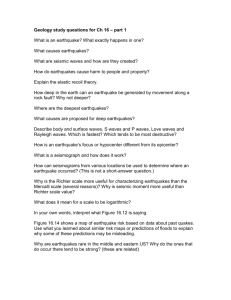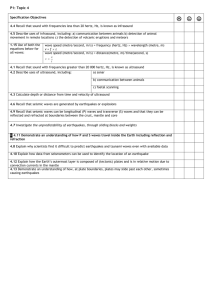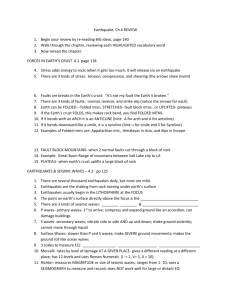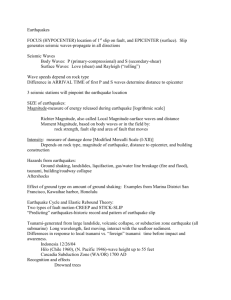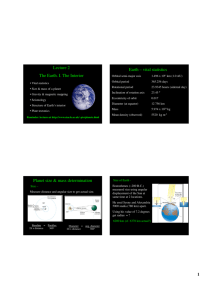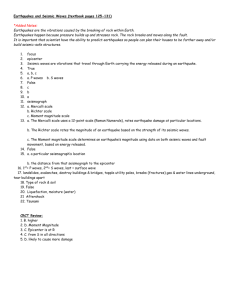File
advertisement
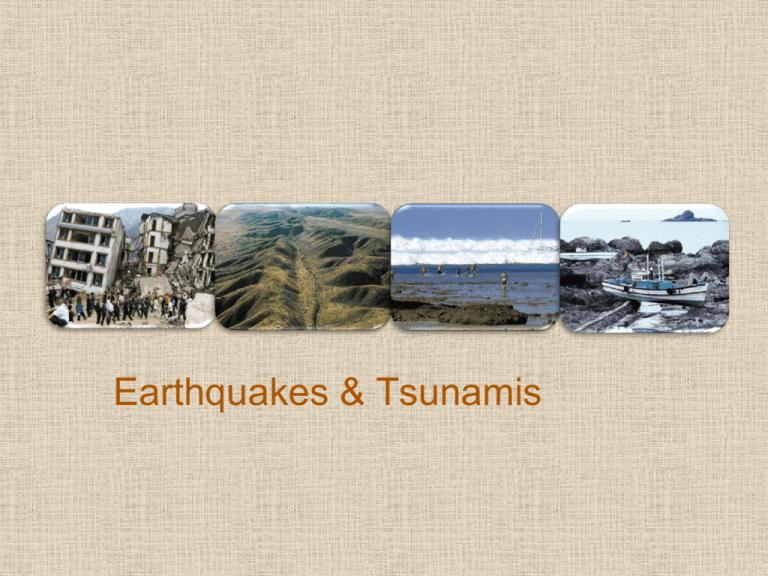
Earthquakes & Tsunamis Speed of Plate movement….where are they the fastest? Where are the earthquakes? How does depth compare to boundary types? Earthquakes • Sudden releases of energy through the earth’s crust • The point within the crust where the quake originated is called the focus. • The point on the surface above the focus is the epicenter • Measured in three ways: • Richter Scale • Moment magnitude Scale • Mercalli Scale Earthquakes • Richter Scale • Based on the logarithm of the amplitude of waves on a seismograph • Logarithmic scale: • Each number on the scale is 31.7 times more powerful Earthquakes • Moment Magnitude Scale • Based on physical properties of the earthquake – Area of fault affected – Distance the earth moved Not based on any seismic readings. Can more accurately measure large earthquakes. Earthquakes • Mercalli Scale • Measures the intensity based on observations and damage. • Useful in areas where data was not recorded. • Used worldwide Earthquakes • Occur at plate boundaries • Type of boundary will determine the fault type • Three main types: • Normal • Thrust/Reverse • Slip-strike Earthquakes at Faults Normal faults • Land falls below normal • Occur frequently at divergent boundaries • Result in weak, shallow earthquakes Reverse/Thrust faults • Land is lifted above normal • Occur frequently at convergent boundaries • Cause strong, deep earthquakes Slip-strike faults • Land is shifted horizontally • Occur at transform boundaries • Cause moderate, shallow earthquakes Hollister, CA: Aseismic creep Seismic Waves • Seismic Waves are waves of energy that travel through the earth. – Body waves: travel through the interior – Surface waves: travel along the crust Seismic Waves • P waves • P waves, or Primary waves, are body waves that travel through the earth with compression. • They are detected first in seismographs • A drop of water spreads using compression. Seismic Waves • S waves, or secondary waves, are body waves that travel through the earth using shearing • Shearing means to stretch something side to side • They are the second waves detected by seismographs Seismic Waves • Surface waves only travel along the earth’s crust, not through the interior. • They move the earth up and down • They are only felt locally Seismic Waves • Seismic waves tell us about the interior of the earth. • First, as waves pass through different layers, they will change speed and bend • Also, S waves cannot travel through liquids. S waves show us where the boundary for the liquid outer core is. Earthquake links • http://earthquake.usgs.gov/earthquakes/re centeqsus/ Tsunamis • A tsunami is a wave with a huge wavelength, often several hundreds of miles long. • Where surface wave’s particle rotation only reaches a few meters below the surface, the tsunami’s wave rotation can be felt as deep as the bottom of the ocean. Tsunamis • Tsunamis originate at earthquake epicenters at plate boundaries. • Earthquakes result in the shifting of plate boundaries. • When this occurs under the ocean, the plate and the ocean have to move Tsunamis • A Tsunami is created from an area of ocean bottom being suddenly lifted up or sinking. • This will displace the water above it, creating the tsunami. Tsunamis As the tsunami nears land, the beginning trough will be seen as water retreating from the shoreline and heading out to sea. After that, the water will begin to rise until the wave crest arrives. A tsunami acts more like a giant wall of rising water than a wave. Tsunamis • There is a tsunami detection system in place in the Pacific Ocean. • It saves millions of lives every year. • http://www.education.noaa.gov/Ocean_an d_Coasts/Tsunami.html


